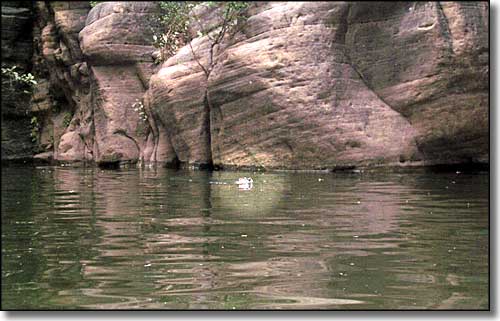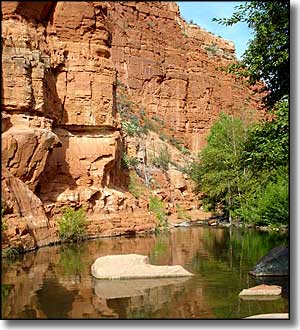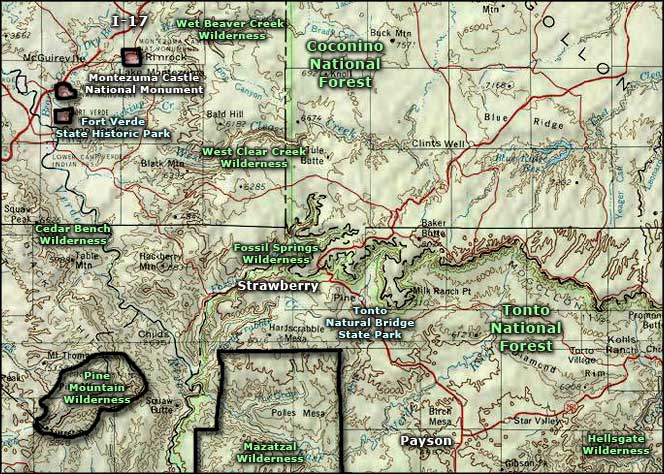
West Clear Creek Wilderness

An otter in the creek

West Clear Creek has cut a deep, narrow canyon into the Mogollon Rim of the Colorado Plateau, a canyon so narrow that a hike along the bottom requires that you also wade or swim through 15 to 20 pools stretching from one sheer canyon wall to the other. Some of these pools are up to a 1/4 mile long. At least Arizona Game and Fish keeps the creek well-stocked with trout...
Hikers often use trails that descend from the canyon rim to get at those trout or just to find a good swimming hole. The weekend folks mostly use the trails that lead up from the canyon mouth. A lot of these folks camp at the primitive camping area near Bull Pen Ranch. Elevations vary from about 3,700' to about 6,800'. The West Clear Creek Wilderness contains about 15,238 acres, most of it stretching out for about 20 miles along this canyon that rises up eastward to meet the edge of the Mogollon Rim. The canyon varies from about 1/2 mile to maybe 2 miles wide through that distance. Summer can be quite hot in the lower areas while the upper areas remain moderately cool. The stream flows year round. That water can be really cold in the springtime so be careful of hypothermia problems if you decide to swim in some of the pools. Another thing to watch for is flash flooding in the summer and winter seasons. If you see rain coming you want to get out of the canyon bottom quickly.
In the upper areas, the vegetation consists of lots of Ponderosa pine and Douglas fir. Further down the stream (and down the hill) you'll find sycamore, cottonwood, alder, ash, walnut and willow. The undergrowth will have wild grape, and those things that look kinda like ivy trees: they're actually poison ivy growing in optimum conditions. Fair Warning! Get up the slope a bit from the stream bed and you'll find pinon and juniper, mesquite and hackberry. Further down the hill you'll find catclaw, scrub oak, prickly pear and other cactus.
The wildlife makes this canyon an interesting place, too. There are bears and mountain lions from one end of the canyon to the other. You'll also find elk and deer in the upper sections. The lower sections sport javelina, skunk, fox, coyote, rabbit, squirrel, and coatimundi (ringtail). You also need to be aware of the presence of rattlesnakes, centipedes and scorpions: don't put your hands where you can't see and be really careful at night when these guys come out to hunt.
Hundreds of years ago the Sinagua people built many dwellings in the West Clear Creek drainage. Ruins, tools and other artifacts can be found all through the area. If you find something, enjoy it, and then put it back as you found it.
The geology exposed in the canyon reaches back some 300 million years to the Pennsylvanian Period of the Paleozoic Era. At that time Arizona was being built up of red sandstones and limy shales at the bottom of a shallow sea. 280 million years ago the Permian Period saw the landscape alternating between a terrestrial and marine environment. This is seen in the Upper Supai sandstones embedded with limestones and shales. The Supai Formation was overlaid by the eroded Hermit Shale, which, in turn, was overlaid by the Coconino Sandstone, a layer of wind-blown sand dunes. Above that is the Toroweap Formation and the Kaibab Limestone, both laid down toward the end of the Permian Period. These formations have been eroded out of most of the canyon but can still be seen along the upper reaches, just below the thick layer of cinders, ash and lava from the Quaternary Period of the Cenozoic Era. This is the volcanic material that tops the Mogollon Rim area of the Colorado Plateau.
The lower reaches of the West Clear Creek Wilderness are located about 12 miles east of Camp Verde via FR's 214 and 215 off of FR 618. The upper parts of the canyon are accessible via the Tramway and Maxwell Trails off of FR's 81 and 81E. The Tramway and Maxwell Trails are both steep but regularly maintained. The West Clear Creek Trail starts in the Bull Pen area at the end of FR 215 and heads about 6 miles up the canyon bottom before turning north up a side canyon and climbing up to Cedar Flat (at the end of FR 214). With the exception of the West Clear Creek Trail, there are no maintained trails in the canyon bottom. A journey down canyon from east to west (upper to lower) can take 6 or 7 days. In places, the canyon's steep walls rise about 1,000' above the stream. Because of the topography, rescue access is extremely difficult. You might also want to carry an air mattress or other flotation aid because there's a lot of pools, some are long, and they are liable to be quite cool to downright cold. Don't make this trip alone and make sure someone outside knows your route and schedule, just in case.

West Clear Creek Wilderness map

West Clear Creek Wilderness area map
